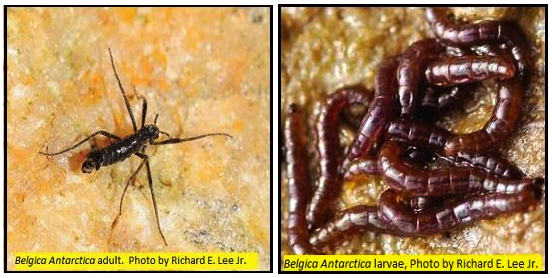The largest land animal in Antarctica is actually very small.
No, not a seal; not a penguin or other type of bird; because they are considered to be marine animals not land animals, as they live mostly in the sea and source their food from there.
The largest land animal in Antarctica is, in fact, only 6mm to13 mm long. It is a wingless midge (a type of fly – though why they call it that when it can’t fly, I don’t know) called Belgica Antarctica.

Antarctica is pretty harsh on insect life so it is the only insect species that survives all year round on Antarctica.
It was first noticed by a naturalist aboard the S.Y. Belgica, a Belgian exploratory ship that sailed the waters off the Antarctica Peninsula at the end of the 19th century, hence the name Belgica.
The larval stage of this insect is encased in ice for most of the year but can survive the freezing of its body fluids and dehydrate its tissues down to 35% of its normal weight.
It lives for two years building up energy before turning into the adult form. The adult is only active in the summer and lives for a brief seven to ten days while it mates and lays eggs. It mainly eats algae and bacteria.
B. Antarctica has the smallest insect genome discovered so far – Only 99 million base pairs (compared to a human with 3.2 billion base pairs).
The effective population size of B. antarctica has been decreasing over the past 10,000 years. It seems likely that they had the greatest population just prior to the last glacial maximum.
In a report in the journal ‘Nature’, one of the researchers, David Denlinger, of Ohio State University said:
“They look like dried-up little raisins, and when we pour water on them they plump up and go on their merry way. Being able to survive that extreme level of dehydration is one of the keys to surviving low temperatures. This midge has some mechanism that enables it to both be dehydrated and stay alive, with its cells functioning normally.”
Belgica antarctica also has the smallest genome ever sequenced with 99 million base pairs of nucleotides (DNA’s building blocks) compared to humans, for instance, with 3.2 billion base pairs.
OK so it may not be as impressive as a Polar Bear but it is pretty interesting and doesn’t bite like a sandfly or draw blood like a mosquito so I think it’s great. By the way did you know that Antarctica is the only continent that doesn’t have ants on it? Strange for a place called ANTarctica 🙂

